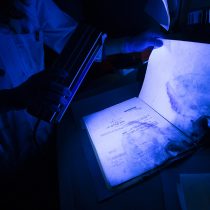Magazine

Out With the Mold, in With the New
by Lara Zielin
When the Bentley’s conservators get word that a new collection might contain inactive mold, “we drop everything else and get to work on it,” says Lead Conservator Dianna Samuelson.
Inactive mold is often dry, but under the right conditions, it can spread or be reactivated. That’s why it’s critical to identify and remediate it right away.
First, Samuelson and her colleague, Conservator Corinne Robertson, make sure to quarantine the materials so any potential mold spores can’t be transmitted to other collections.
Then, they work to determine if mold is truly present or if it’s something else like dirt or soot.
Not all inactive mold can be seen with the naked eye, so they might use a magnifier or an ultraviolet (UV) light, pictured here. Under UV light, some mold will fluoresce, often in spectacularly bright colors like hot pink or orange.
If mold is present, the conservators will manually surface-clean it under an air extraction system, which removes any errant spores from the air as they work. They may also remove the mold with a HEPA (High-Efficiency Particulate Air) vacuum. If the item will tolerate it, they use isopropyl alcohol and/or heat.
The conservators will green-light the collection for the stacks only when they’re certain that remediation is complete.
